The common ostrich is the world’s largest flightless bird, standing up to 2.8 meters (9.2 feet) tall and weighing close to 160 kilograms (353 pounds). Its powerful legs, long neck, and impressive size make it an unmistakable figure across the African savannas. Close relatives such as the Somali ostrich, emu, and the southern and northern cassowaries are also among the heaviest and tallest living birds, each uniquely adapted to their environments.
In total, there are more than 60 flightless bird species alive today, ranging from towering ratites to tiny island dwellers like kiwis. In this article, we focus on the largest extant flightless birds, exploring not only their record-breaking size, but also their ecological roles, behavior, and the threats they face in the modern world. We also take a look at some of the colossal extinct species that once dominated their ecosystems, including the towering giant moa and the massive elephant bird.
Common ostrich (Struthio camelus)
- Height: Up to 2.8 m (9.2 ft).
- Weight: Up to 156.8 kg (345.7 lb).
- Where found: Widely distributed across sub-Saharan Africa; prefers savannas, arid plains, and open woodlands
- Conservation status: Least Concern, though some regional populations face habitat loss and hunting pressure.
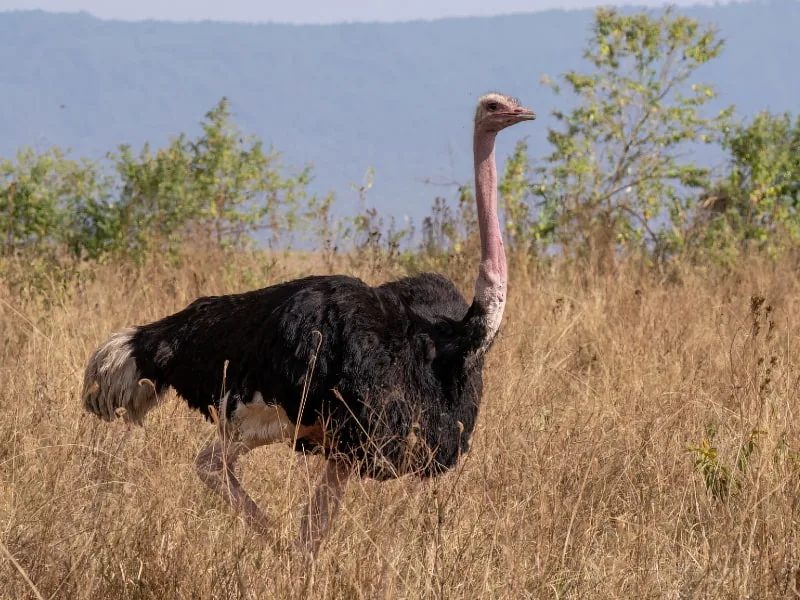
The common ostrich is the tallest and heaviest bird in the world, standing up to 2.8 meters (9.2 feet) tall and weighing as much as 156.8 kilograms (345.7 pounds). Individuals from North African populations tend to be larger than their southern counterparts. Though flightless, ostriches have massive wings that can span up to 2 meters (6.6 feet) comparable to some of the largest flying birds. These wings are used for balance, mating displays, and threat displays, rather than flight.
Ostriches are highly adapted to open terrain, with powerful legs that make them the fastest-running bird in the world. They can sustain speeds over 70 km/h (43 mph), with bursts approaching 97 km/h (60 mph), and can cover up to 5 meters (16.4 feet) in a single stride thanks to their long legs and strong musculature. While primarily herbivorous, ostriches can be aggressive when threatened. They are known to deliver deadly kicks with clawed feet, making them one of the most dangerous birds in the world when cornered or defending their territory or young.
Somali ostrich (Struthio molybdophanes)
- Height: Up to 2.75 m (9 ft).
- Weight: Up to 130 kg (286.6 lb).
- Where found: Arid and semi-arid regions of the Horn of Africa, particularly in Somalia, Ethiopia, and northern Kenya.
- Conservation status: Vulnerable, due to hunting and habitat degradation.
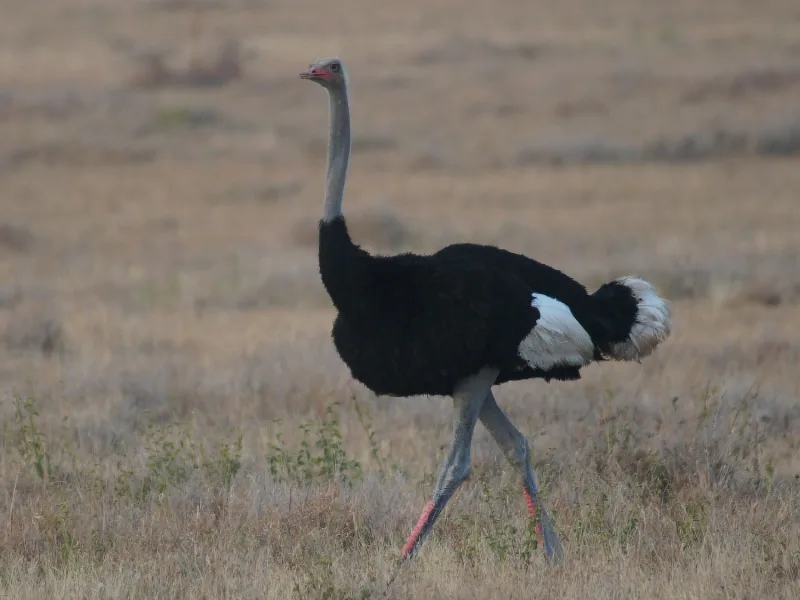
The Somali ostrich is the second-largest living bird, reaching heights of up to 2.75 meters (9 feet) and weighing as much as 130 kilograms (286.6 pounds). Once considered a subspecies of the common ostrich, it was recognized as a distinct species in recent years based on differences in range, behavior, and physical traits. Though slightly smaller than its more widespread relative, it remains an imposing bird with powerful legs and a commanding presence in the dry landscapes of East Africa.
Unlike the common ostrich, whose males develop pink necks and thighs during the breeding season, the Somali ostrich has a bluish-gray neck and thighs year-round, lacking the seasonal coloration seen in other ostrich species. It is well adapted to hot, arid environments and tends to avoid open grasslands, favoring bushier or more rugged terrain. While it shares similar behaviors, such as strong running ability and aggressive defense when threatened, ongoing hunting pressure and habitat fragmentation have led to a decline in its populations.
Southern cassowary (Casuarius casuarius)
- Height: Up to 1.9 m (6.2 ft).
- Weight: Up to 85 kg (187.4 lb).
- Where found: Tropical rainforests of northeastern Australia, New Guinea, and nearby islands.
- Conservation status: Least Concern, though locally impacted by habitat loss, vehicle collisions, and dog attacks.
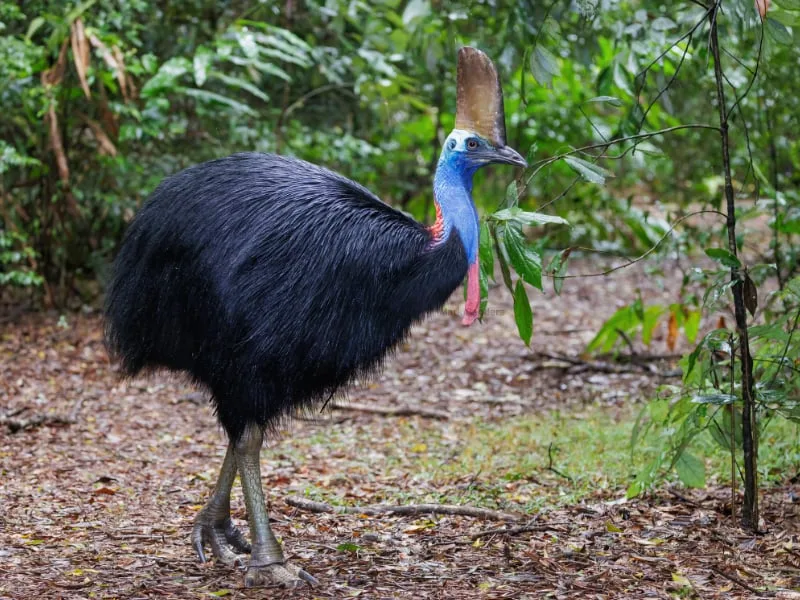
The southern cassowary is a heavy, flightless bird, reaching up to 85 kilograms (187.4 pounds) in weight and standing as tall as 1.9 meters (6.2 feet). Its glossy black plumage, vivid blue and red neck, and tall casque (helmet-like crest) give it a prehistoric appearance. Though its wings are tiny and hidden beneath coarse feathers, its muscular legs and three-toed feet are built for power and speed.
Southern cassowaries are typically solitary and elusive, foraging for fallen fruit in dense rainforest habitats. Despite their secretive nature, they are also notoriously dangerous when provoked. Equipped with dagger-like claws on each foot, especially the long inner toe, they can deliver slashing kicks capable of inflicting serious injury. Human encounters, though rare, have occasionally resulted in attacks. Cassowaries play a vital ecological role as seed dispersers, but their populations are under growing pressure from deforestation, road traffic, and invasive species.
Northern cassowary (Casuarius unappendiculatus)
- Height: Up to 1.8 m (5.9 ft).
- Weight: Up to 75 kg (165.3 lb).
- Where found: Lowland rainforests of northern New Guinea and surrounding islands.
- Conservation status: Least Concern, though locally affected by habitat loss and hunting.
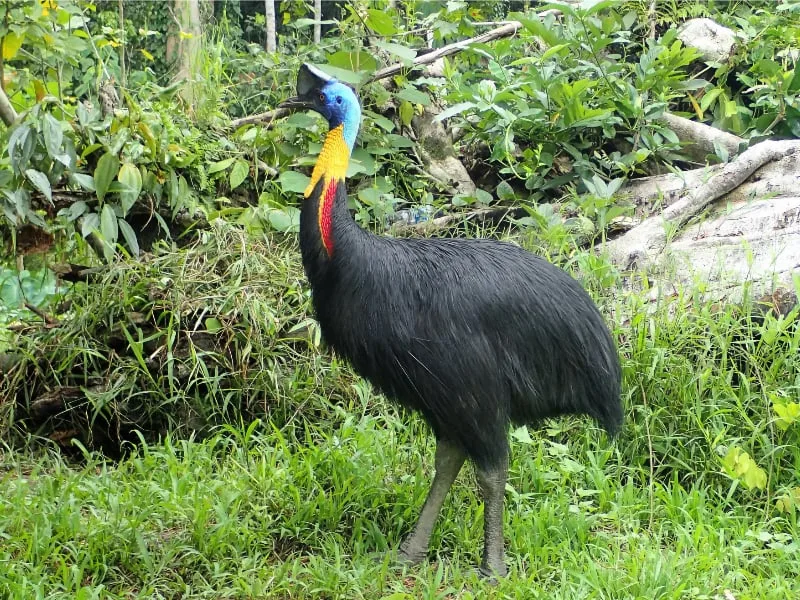
The northern cassowary is a large, flightless bird reaching up to 1.8 meters (5.9 feet) in height and weighing as much as 75 kilograms (165.3 pounds). Slightly smaller than the southern cassowary, it is nonetheless a heavy and powerful species with a striking appearance. It features glossy black plumage, a tall casque, and a vivid blue neck accented by red markings, though it differs by having only one prominent wattle instead of two.
This species inhabits dense lowland rainforests, where it plays a vital role in seed dispersal. It is solitary and secretive, foraging for fallen fruit and other plant material. Like its relatives, the northern cassowary can be dangerous when provoked, using its strong legs and sharp claws to defend itself. While considered of Least Concern overall, some populations face pressure from hunting and habitat destruction due to logging and agriculture.
Emu (Dromaius novaehollandiae)
- Height: Up to 1.9 m (6.2 ft).
- Weight: Up to 60 kg (132.3 lb).
- Where found: Widespread across mainland Australia; favors savannas, woodlands, and grasslands.
- Conservation status: Least Concern, though local pressures include habitat fragmentation and vehicle collisions.

The emu is the second-tallest living bird, reaching up to 1.9 meters (6.2 feet) in height and weighing as much as 60 kilograms (132.3 pounds). Although not as heavy as the ostrich, its build is robust, with strong legs and a long neck that give it a striking silhouette on the Australian landscape. While flightless, the emu’s wings are small and vestigial, mainly used for balance while running.
Despite its size, the emu is a fast and agile runner, capable of sprinting up to 50 km/h (31 mph). At full gallop, it can take strides as long as 2.75 meters (9 feet), allowing it to quickly cover ground across open terrain. Emus are highly adaptable and mostly nomadic, moving in search of food and water. They are omnivorous and opportunistic, feeding on seeds, fruits, insects, and small animals. While not typically aggressive, emus can defend themselves with powerful kicks when cornered or threatened.
Greater rhea (Rhea americana)
- Height: Up to 1.83 m (6 ft).
- Weight: Up to 40 kg (88.2 lb).
- Where found: Grasslands, savannas, and open woodlands of South America, primarily in Brazil, Argentina, Paraguay, Uruguay, and Bolivia.
- Conservation status: Near Threatened, with declines due to habitat loss, hunting, and agricultural expansion.
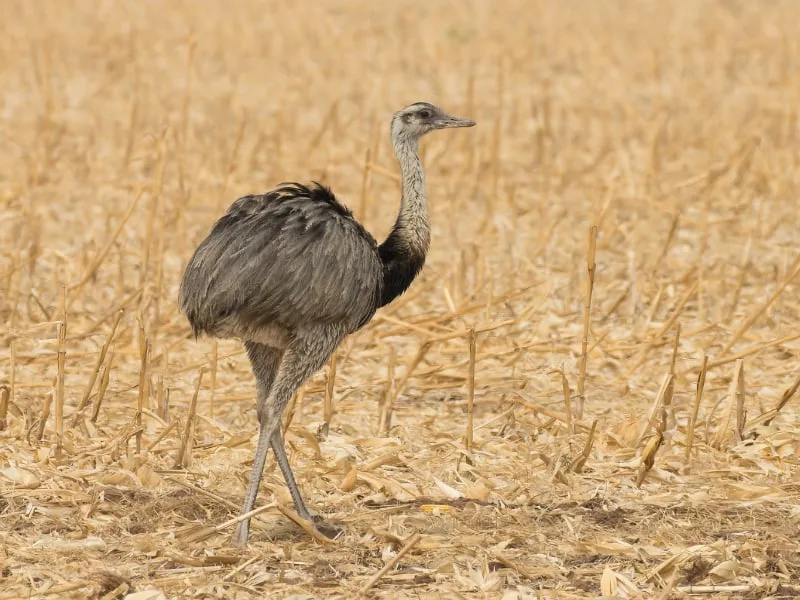
The greater rhea is the largest bird in the Americas, reaching up to 1.83 meters (6 feet) in height and weighing as much as 40 kilograms (88.2 pounds). Though slightly built compared to ostriches and cassowaries, it still presents an impressive figure on the open South American plains. Its long legs and neck, along with soft gray or brown plumage, give it a somewhat shaggy appearance. Like all ratites, it is flightless, but capable of running at high speeds to escape predators.
Greater rheas are adaptable and primarily herbivorous, feeding on a variety of plants, seeds, and fruits, though they also consume insects and small vertebrates. They are typically found in small groups, but may form larger flocks outside the breeding season. Males take on the unusual role of incubating eggs and raising chicks, often caring for the offspring of multiple females in a single nest. The species faces ongoing threats from habitat conversion to farmland, hunting, and competition with livestock, contributing to a gradual population decline across parts of its range.
Dwarf cassowary (Casuarius bennetti)
- Height: Up to 1.35 m (4.4 ft).
- Weight: Up to 34 kg (75 lb).
- Where found: Mountain forests of New Guinea, New Britain, and Yapen Island.
- Conservation status: Least Concern, though some populations are affected by hunting and habitat loss.
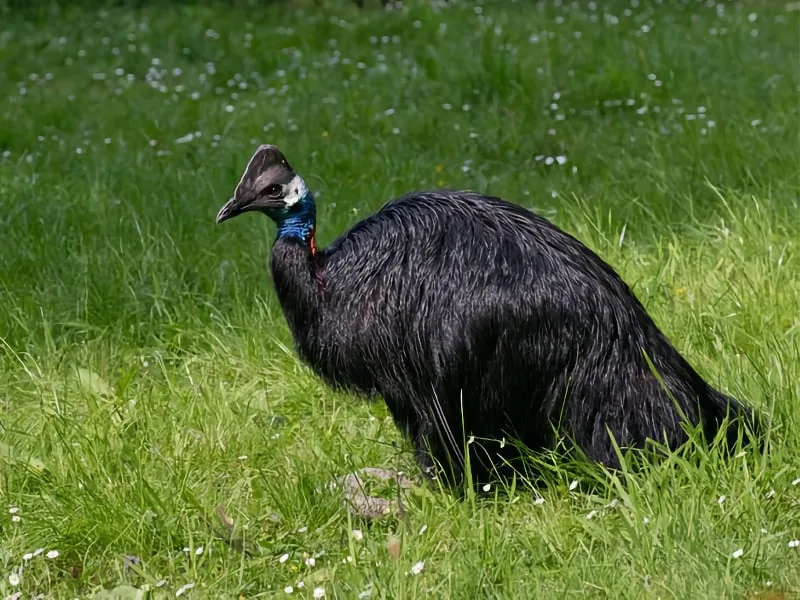
The dwarf cassowary is the smallest of the three cassowary species, standing up to 1.35 meters (4.4 feet) tall and weighing as much as 34 kilograms (75 pounds). Although smaller than its cassowary relatives, it is still a substantial bird with the typical features – dense black plumage, a vivid blue and red neck, and a prominent casque atop the head. Its body is more compact and rounded, suited to life in steep, forested terrain.
Adapted to the montane rainforests of New Guinea and surrounding islands, the dwarf cassowary is an elusive and solitary bird. It feeds on fallen fruit, fungi, and small animals, playing an important role in forest ecology as a seed disperser. While generally shy, it can be defensive when threatened and is equipped with sharp claws like its larger relatives. Although not globally threatened, the species faces localized pressures from hunting and habitat fragmentation, especially where human encroachment into upland forests is increasing.
Emperor penguin (Aptenodytes forsteri)
- Height: Up to 1.2 m (3.9 ft).
- Weight: Up to 45.4 kg (100 lb).
- Where found: Antarctic coasts and surrounding pack ice.
- Conservation status: Near Threatened, primarily due to climate change and sea ice loss.

The emperor penguin is the tallest and heaviest of all living penguin species, standing up to 1.2 meters (3.9 feet) tall and reaching a weight of 45.4 kilograms (100 pounds). Unlike the towering ostriches and cassowaries, the emperor penguin is built for swimming, not speed on land. Its streamlined body, dense waterproof feathers, and thick layer of blubber allow it to thrive in the extreme cold of Antarctica. Though flightless, it is a powerful underwater hunter capable of diving over 500 meters in search of fish, squid, and krill.
Emperor penguins are uniquely adapted to life on the sea ice, where they breed during the harsh Antarctic winter. They form large colonies where males incubate a single egg on their feet for more than two months without feeding, while females return to the sea to hunt. Their dependence on stable sea ice makes them particularly vulnerable to climate change, with warming temperatures reducing both breeding habitat and food availability. Despite current population numbers in the hundreds of thousands, future declines are projected if global warming continues.
Lesser rhea (Rhea pennata)
- Height: Up to 1 m (3.3 ft).
- Weight: Up to 28.6 kg (63 lb).
- Where found: Open plains and scrublands of southern South America, particularly Patagonia and the Andean foothills.
- Conservation status: Least Concern, though some subspecies are locally threatened by habitat loss and hunting.
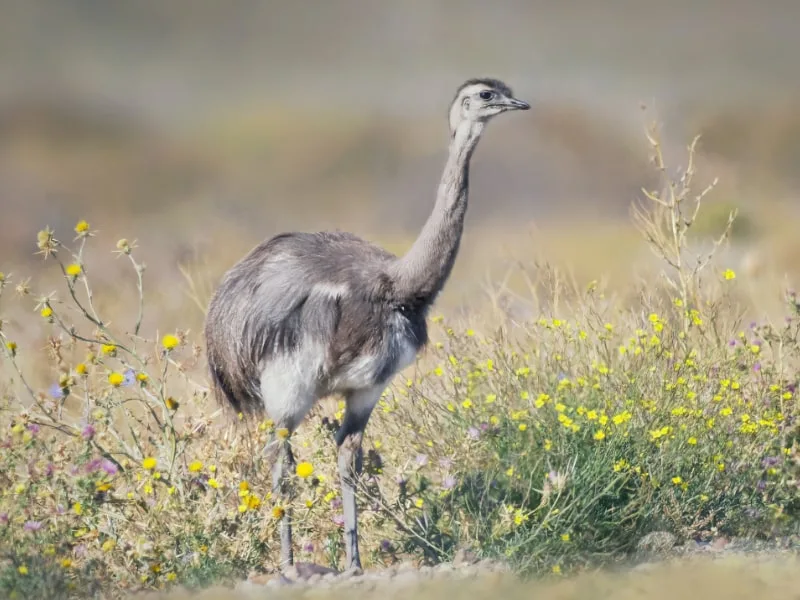
The lesser rhea is a flightless bird native to the open landscapes of southern South America. Standing up to 1 meter (3.3 feet) tall and weighing as much as 28.6 kilograms (63 pounds), it is notably smaller than the greater rhea but still impressive in stature. It has a compact body covered in brownish-gray feathers, long legs adapted for running, and a relatively short neck compared to its larger cousin.
Highly adapted to cold, arid environments, the lesser rhea is a swift runner and can reach considerable speeds to evade predators. It is primarily herbivorous, feeding on grasses, seeds, and shrubs, but will also consume insects and other small animals when available. Males take on parental duties, incubating eggs from multiple females and caring for the chicks after hatching. While the species as a whole is classified as Least Concern, certain subspecies, like the puna rhea (Rhea pennata tarapacensis), face greater pressure from habitat fragmentation and human disturbance.
Fuegian steamer duck (Tachyeres pteneres)
- Weight: Up to 7 kg (15.4 lb).
- Body length: Up to 84 cm (2.75 ft).
- Where found: Coastal waters and rocky shores of southern Chile and Argentina, including Tierra del Fuego.
- Conservation status: Least Concern, though vulnerable to oil pollution and human disturbance.
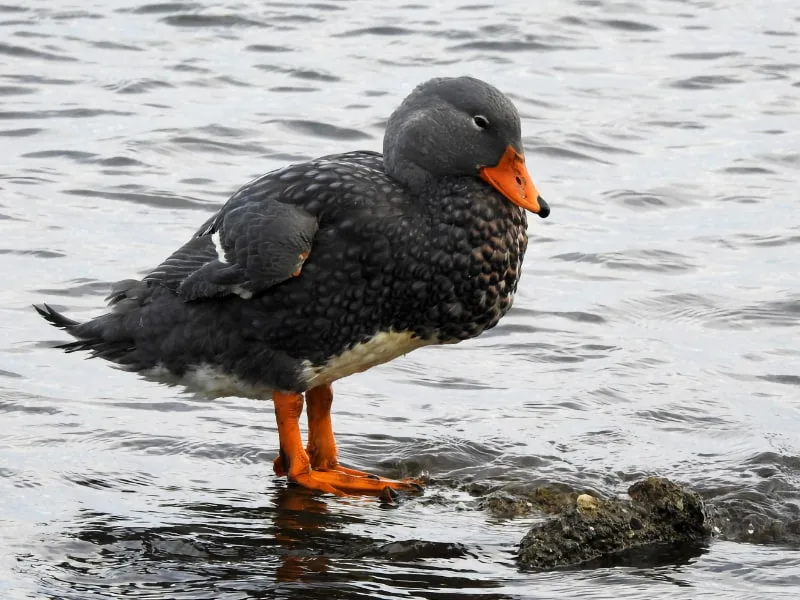
The Fuegian steamer duck is one of the heaviest members of the duck family and one of only a few duck species that are completely flightless. Measuring up to 84 centimeters (2.75 feet) in body length and weighing as much as 7 kilograms (15.4 pounds), it has a thickset body, short wings, and dense waterproof plumage. Its wings can reach a span of about 110 centimeters (3.6 feet), but they are too small and weak relative to its body mass to support flight.
Instead of flying, this powerful duck “steams” across the water using its wings like paddles – hence its name. It is a strong swimmer and highly territorial, often engaging in fierce fights with rivals. The Fuegian steamer duck feeds primarily on marine invertebrates and small fish, foraging along rocky coastlines. While its population is currently stable, localized threats include oil spills, increasing human activity, and coastal habitat degradation.
Flightless cormorant (Nannopterum harrisi)
- Weight: Up to 5 kg (11 lb).
- Body length: Up to 100 cm (3.3 ft).
- Where found: Coastal areas of Fernandina and Isabela Islands in the Galapagos.
- Conservation status: Vulnerable, due to its small range and sensitivity to environmental changes.

The flightless cormorant is a unique evolutionary offshoot among seabirds, growing up to 100 centimeters (3.3 feet) in length and weighing as much as 5 kilograms (11 pounds). It is the only species of cormorant that has completely lost the ability to fly. Over generations of isolation on the Galapagos Islands, its wings have become small and stubby – useless for flight but still employed for balance and display. Despite its reduced wingspan, it remains an excellent swimmer and diver.
This species feeds primarily on fish, octopus, and other marine life, which it catches during underwater hunts along the rocky coastlines. It has a low reproductive rate and is highly localized, making it vulnerable to environmental disturbances, invasive species, and climate events like El Nino. Conservation efforts, including habitat protection and monitoring, are critical to its long-term survival, as its entire global population is confined to a small area in the western Galapagos.
Great spotted kiwi (Apteryx maxima)
- Weight: Up to 3.3 kg (7.3 lb).
- Body length: Around 50 cm (19.7 in).
- Where found: Forests and subalpine zones of the northern South Island, New Zealand.
- Conservation status: Vulnerable, due to predation by introduced mammals and habitat loss.

The great spotted kiwi is the largest of the five kiwi species, measuring around 50 centimeters (19.7 inches) in length and weighing up to 3.3 kilograms (7.3 pounds). Unlike the tall and powerful ratites, it has a compact, rounded body covered in shaggy, hair-like feathers. Its vestigial wings are hidden beneath this dense plumage, and it has no tail. The bird’s long, slender bill with nostrils at the tip is uniquely adapted for probing soil and leaf litter in search of invertebrates.
Nocturnal and highly territorial, the great spotted kiwi inhabits remote, rugged terrain. It relies on its excellent sense of smell and touch to forage, and it mates for life. Despite its elusive nature, it faces significant threats from introduced predators like stoats, dogs, and feral cats, which prey on eggs and chicks. Conservation programs involving predator control and habitat protection are essential to ensuring the species’ survival in the wild.
Kakapo (Strigops habroptilus)
- Weight: Up to 4 kg (8.8 lb).
- Body length: Up to 64 cm (25.2 in).
- Where found: Predator-free islands off New Zealand, formerly widespread across the mainland.
- Conservation status: Critically Endangered, with a small managed population under intensive conservation.
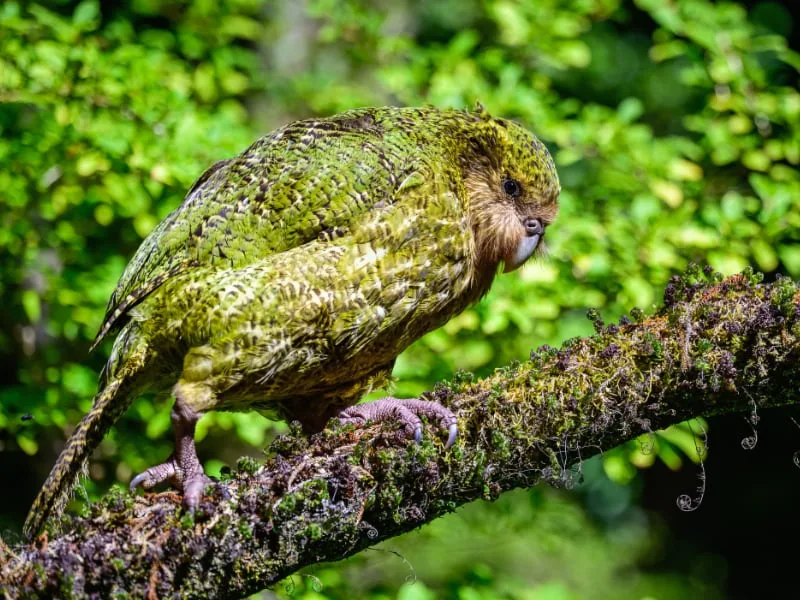
The kakapo is the world’s only flightless parrot and the heaviest parrot species, reaching up to 64 centimeters (25.2 inches) in length and weighing as much as 4 kilograms (8.8 pounds). It has short wings and a wingspan of up to 82 centimeters (32.3 inches), though it cannot fly. Instead, it uses its wings for balance while climbing and to break its fall when leaping from trees. Covered in soft, mossy green plumage, the kakapo is also nocturnal and emits a strong, musky scent – traits that make it truly one-of-a-kind among parrots.
Once widespread across New Zealand, the kakapo was driven to the brink of extinction by habitat loss and introduced predators. Today, it survives only on a handful of predator-free offshore islands under one of the most intensive conservation programs in the world. As one of the rarest and most endangered birds on the planet, it is long-lived, slow to reproduce, and breeds only in years when certain forest trees mast (produce abundant fruit). Despite these challenges, conservation efforts have brought its numbers above 250 individuals, and the kakapo now stands as a global symbol of successful species recovery.
Extinct giants of the flightless world
While today’s flightless birds are remarkable in size and adaptation, they are dwarfed by some of the extinct giants that once roamed the planet. The giant moa (Dinornis), native to New Zealand, holds the record as the tallest bird known to science, with some females reaching a towering height of 3.6 meters (12 feet) and weighing over 250 kilograms (550 pounds). These enormous herbivores disappeared around the 15th century, soon after humans arrived in Aotearoa.
Even more massive was the elephant bird (Aepyornis maximus) of Madagascar, widely considered the heaviest bird to have ever lived. Though shorter than the moa, it may have weighed up to 1,000 kilograms (2,200 pounds), with more conservative estimates around 850 kilograms (1,875 pounds). These giant, egg-laying birds survived until at least the 10th century CE (common era), and likely fell victim to hunting and habitat loss. Together, these species offer a glimpse into a time when birds dominated ecosystems in size as well as number.
Further reading:
